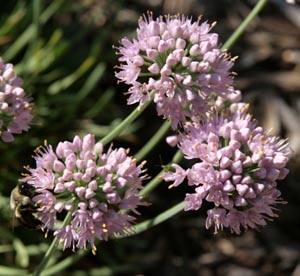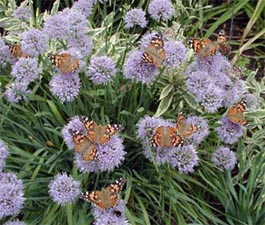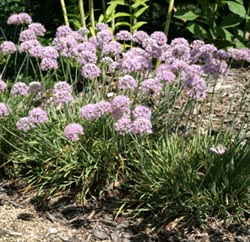
In late summer to early fall, the lilac-pink flowers of Allium senescens spp. glaucum begin to open. This plant has many common names, including German garlic, corkscrew onion, cowlick onion, spiral onion, circle chives or curly chives. The species is native to a wide area from central Europe to Northern Asia (Siberia, China and Korea) and is hardy in zones 3-8. Glaucum, a name applied to an extremely variable group of garden hybrids with glaucous swirling foliage – and sometimes referred to as A. glaucum, A. spirale or A. lusitanicum – is more ornamental and later blooming than the species, but plants offered under this name can vary widely in the color and degree of spiraling of the foliage. Some named selections include ‘Blue Twister’ (brighter blue-green foliage, 12 x 10” wide) and ‘Blue Eddy’ (especially dwarf habit and fine blue-gray swirls of foliage like small swirling eddies of water and pale pink flowers).
This small ornamental onion grows in dense clumps about 10” high and 6-10” wide. Unlike other ornamental onions that are used primarily for their flowers, this one is has very attractive foliage, too. Although the flowers are beautiful, it is the unique foliage that provides long-lasting interest in the garden. The gray to blue-green leaves look great all season long. They are linear, flat and twisted, giving a swirled or curly effect. This feature is most pronounced with the new growth early in the season. The clumps – composed of true bulbs on a rhizome – enlarge slowly and do not require frequent division.

The pink to lavender, cup-shaped flowers open from nodding buds in 1-2” wide umbels on wiry stems held high above the foliage.


The blooms are highly attractive to butterflies, bees and other insects. Deadhead the flowers before they form seeds to prevent possible unwanted self-seeding.
Use A. senescens spp. glaucum as a specimen in a small garden, in masses at the front of the border, or as a neat edging on a small bed. This plant is also well suited to rock gardens, blooming when few other rock garden plants do. Looking somewhat like a low, succulent grass, it is great for adding texture in the perennial garden or mixed bed. Combine it with plants with rounded, lobed leaves, such as geranium, Heuchera or Lady’s mantle (Alchemilla) for a nice contrast in shapes. With its neat clumps, it is also well-suited for a more formal garden, as an edging or for forming patterns with other plants.

A. senescens spp. glaucum does best in full sun; it will grow in light shade but blooms will be sparse. It tolerates a wide range of soils, from fairly heavy clay to sandy loam. In nature, this species is found in dry, rocky places, so once established it is fairly drought tolerant. It doesn’t have any serious insect or disease problems and is not bothered by deer. Propagate by division of the clumps in early spring or fall. Although it can be grown from seed, the resulting plants may not have the color or twisting pattern of the parent.
– Susan Mahr, University of Wisconsin – Madison
Latest from Wisconsin Yard & Garden
Ask Your Gardening Question
If you’re unable to find the information you need, please submit your gardening question here:





 Aster, Symphyotrichum spp.
Aster, Symphyotrichum spp. Fascinating Fasciation
Fascinating Fasciation Alternatives to Lawn: Groundcovers
Alternatives to Lawn: Groundcovers Marigolds
Marigolds


